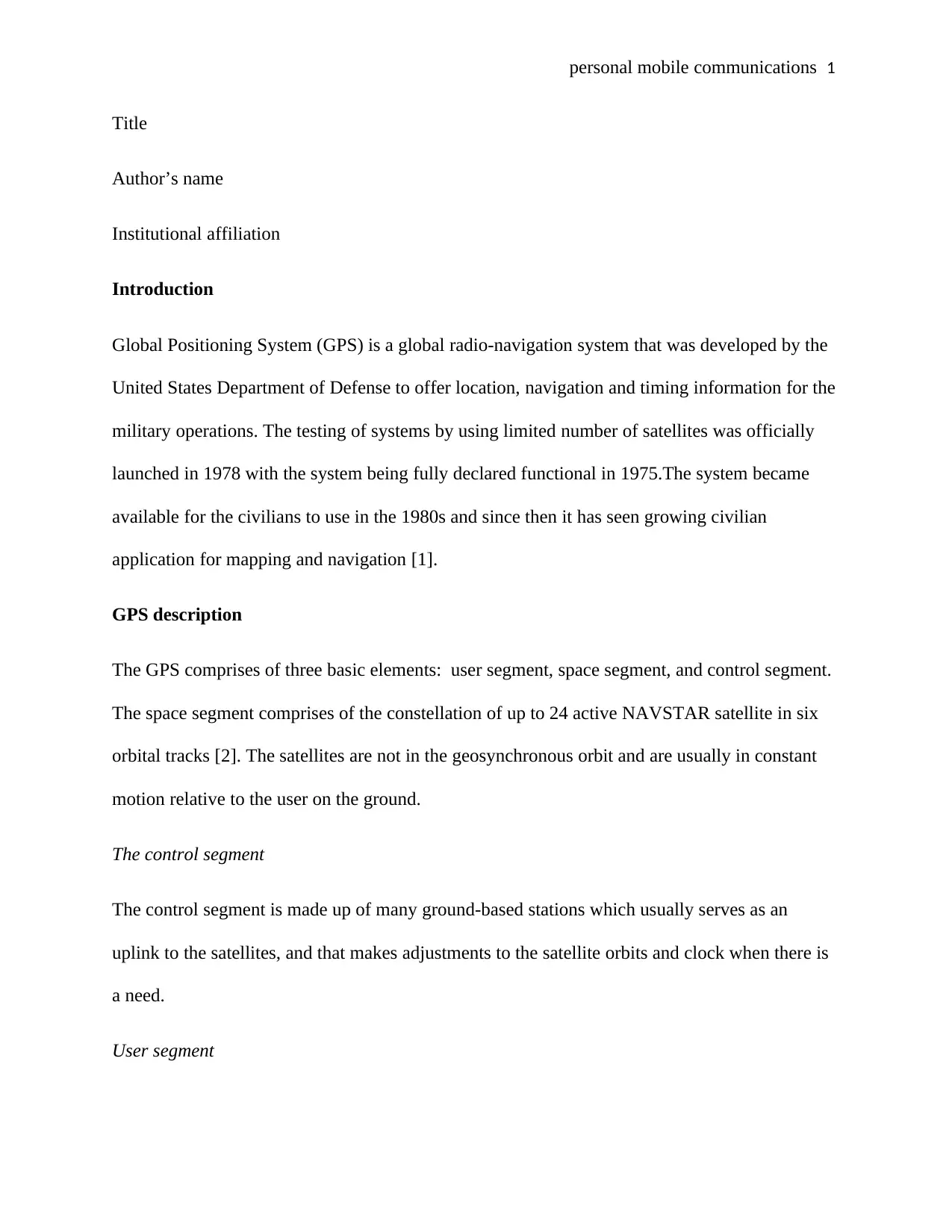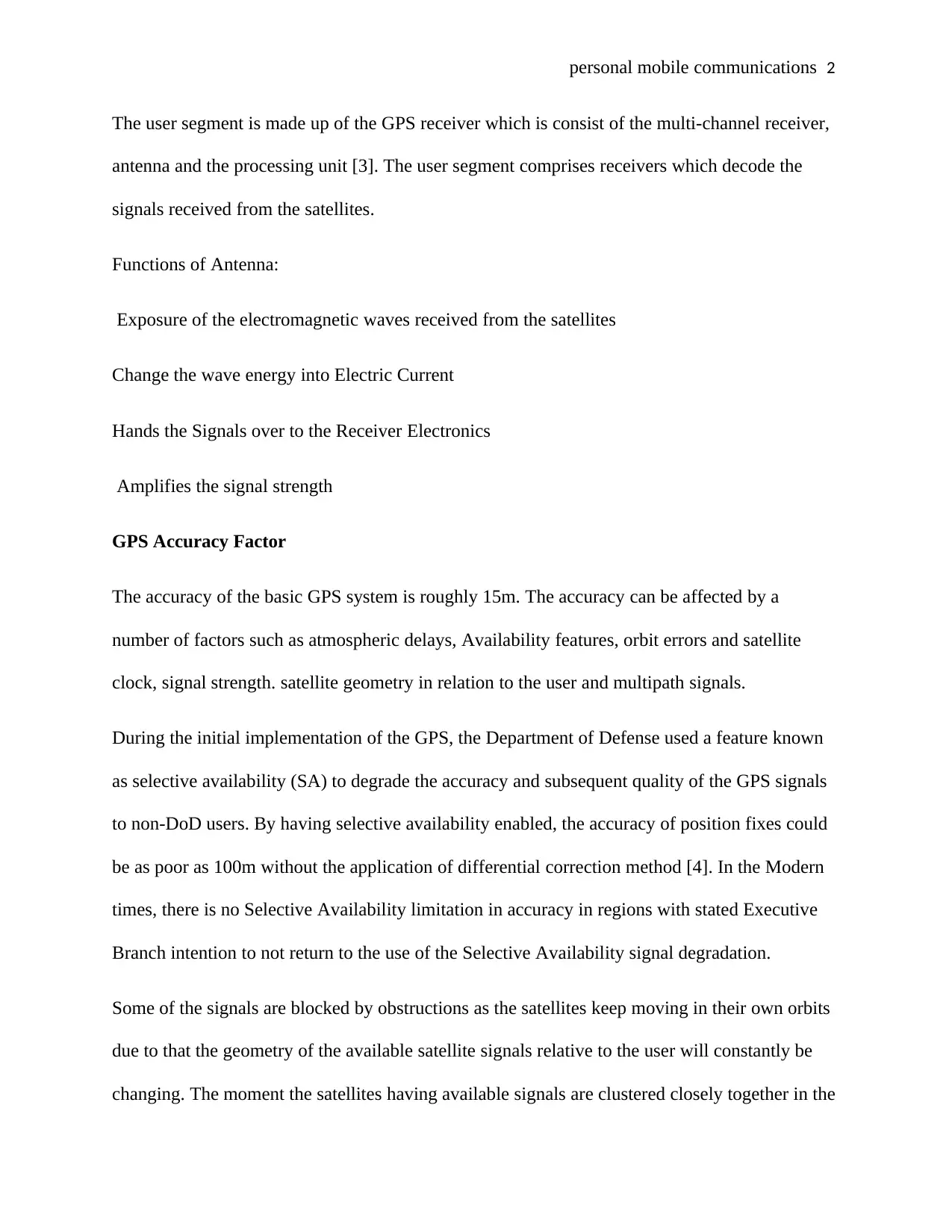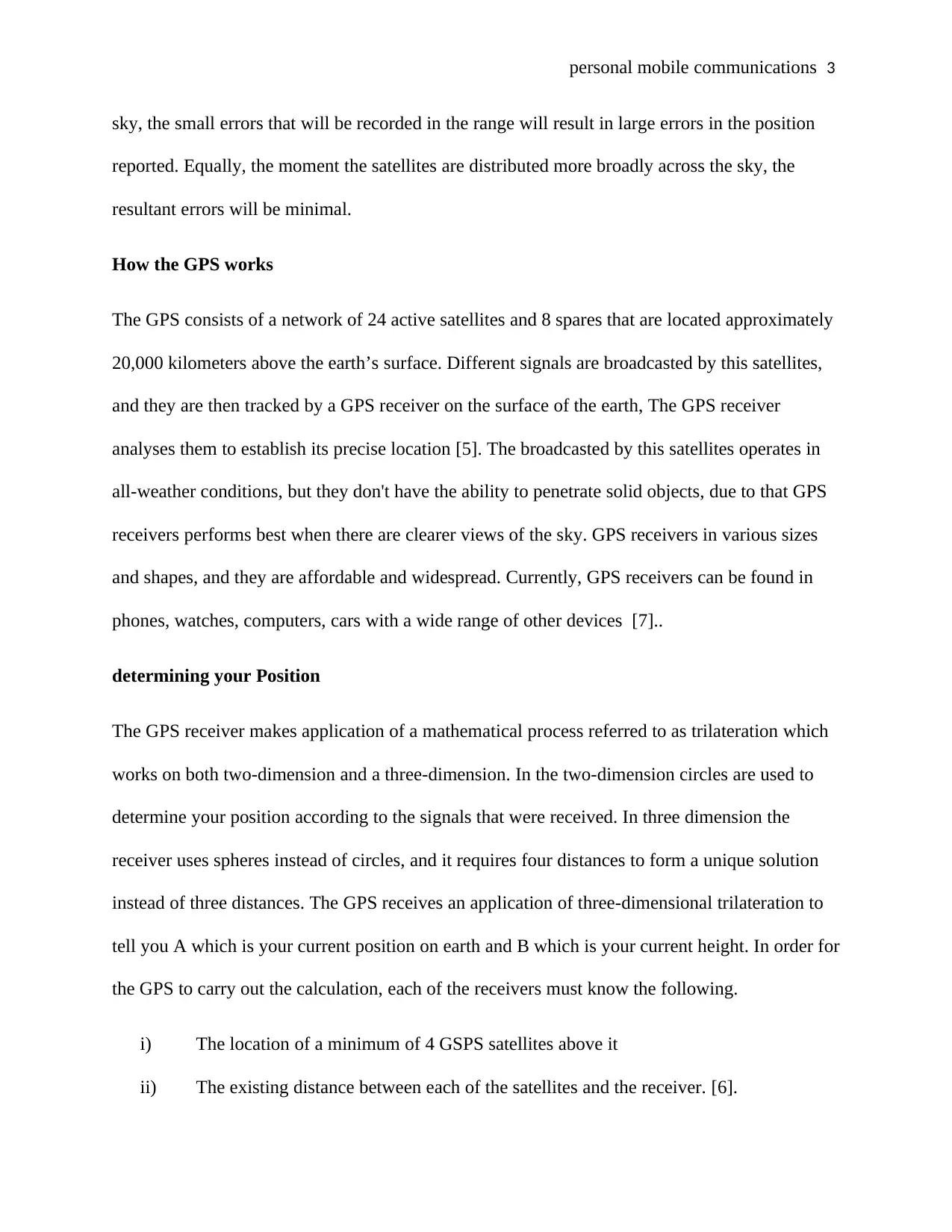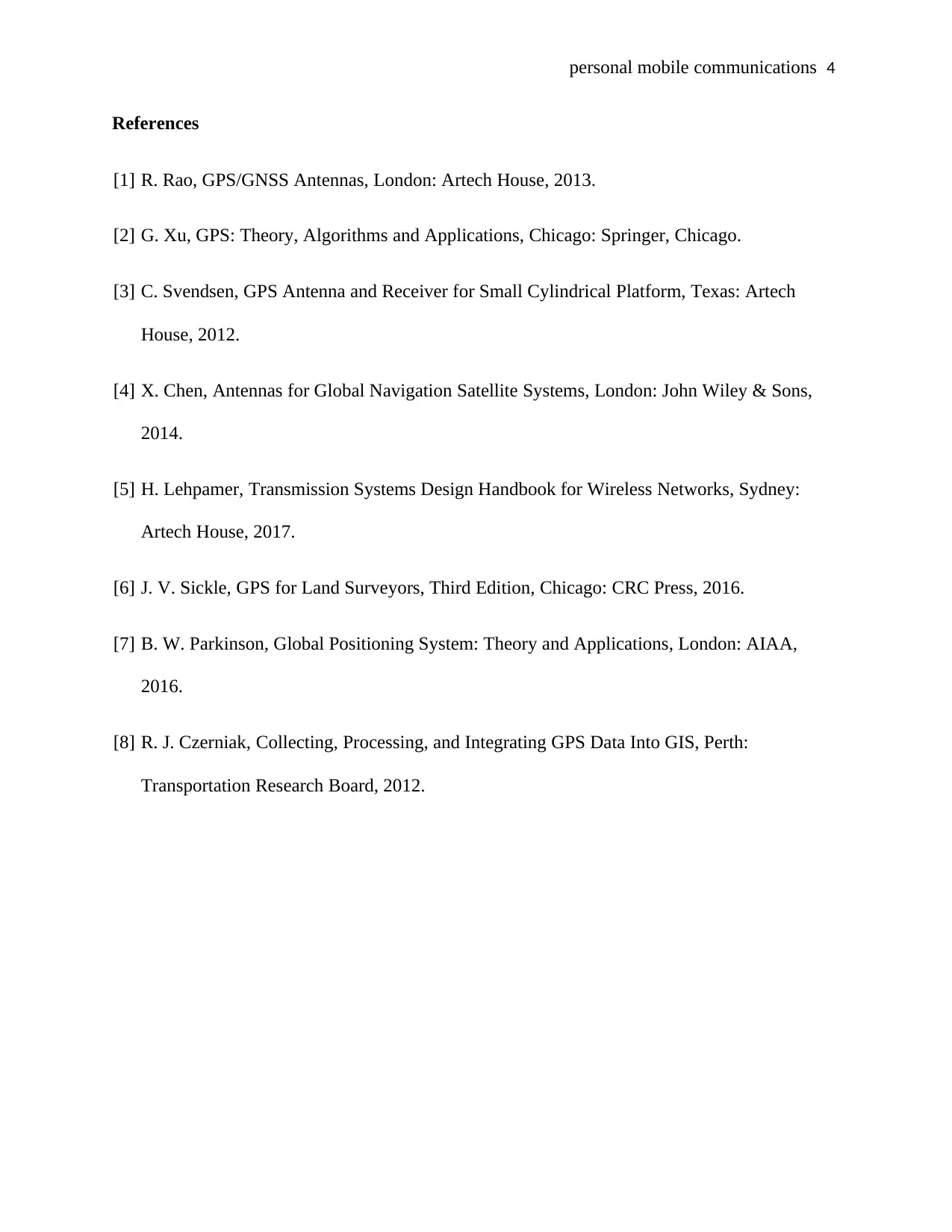Comprehensive Literature Survey: GPS and GPS Antennas for ELE4ACS/5PMC
VerifiedAdded on 2023/06/07
|4
|995
|190
Literature Review
AI Summary
This literature review provides an overview of the Global Positioning System (GPS) and GPS antennas, covering the system's components (user, space, and control segments), accuracy factors, and operational principles. It discusses the role of GPS in providing location, navigation, and timing information, initially for military operations but now widely used in civilian applications. The review also addresses the impact of factors like atmospheric delays, signal strength, and satellite geometry on GPS accuracy, including the historical use of Selective Availability. The document highlights the mathematical process of trilateration used by GPS receivers to determine position and references various sources for further reading on GPS/GNSS antennas and related technologies. Desklib provides access to this and other solved assignments to help students.

personal mobile communications 1
Title
Author’s name
Institutional affiliation
Introduction
Global Positioning System (GPS) is a global radio-navigation system that was developed by the
United States Department of Defense to offer location, navigation and timing information for the
military operations. The testing of systems by using limited number of satellites was officially
launched in 1978 with the system being fully declared functional in 1975.The system became
available for the civilians to use in the 1980s and since then it has seen growing civilian
application for mapping and navigation [1].
GPS description
The GPS comprises of three basic elements: user segment, space segment, and control segment.
The space segment comprises of the constellation of up to 24 active NAVSTAR satellite in six
orbital tracks [2]. The satellites are not in the geosynchronous orbit and are usually in constant
motion relative to the user on the ground.
The control segment
The control segment is made up of many ground-based stations which usually serves as an
uplink to the satellites, and that makes adjustments to the satellite orbits and clock when there is
a need.
User segment
Title
Author’s name
Institutional affiliation
Introduction
Global Positioning System (GPS) is a global radio-navigation system that was developed by the
United States Department of Defense to offer location, navigation and timing information for the
military operations. The testing of systems by using limited number of satellites was officially
launched in 1978 with the system being fully declared functional in 1975.The system became
available for the civilians to use in the 1980s and since then it has seen growing civilian
application for mapping and navigation [1].
GPS description
The GPS comprises of three basic elements: user segment, space segment, and control segment.
The space segment comprises of the constellation of up to 24 active NAVSTAR satellite in six
orbital tracks [2]. The satellites are not in the geosynchronous orbit and are usually in constant
motion relative to the user on the ground.
The control segment
The control segment is made up of many ground-based stations which usually serves as an
uplink to the satellites, and that makes adjustments to the satellite orbits and clock when there is
a need.
User segment
Paraphrase This Document
Need a fresh take? Get an instant paraphrase of this document with our AI Paraphraser

personal mobile communications 2
The user segment is made up of the GPS receiver which is consist of the multi-channel receiver,
antenna and the processing unit [3]. The user segment comprises receivers which decode the
signals received from the satellites.
Functions of Antenna:
Exposure of the electromagnetic waves received from the satellites
Change the wave energy into Electric Current
Hands the Signals over to the Receiver Electronics
Amplifies the signal strength
GPS Accuracy Factor
The accuracy of the basic GPS system is roughly 15m. The accuracy can be affected by a
number of factors such as atmospheric delays, Availability features, orbit errors and satellite
clock, signal strength. satellite geometry in relation to the user and multipath signals.
During the initial implementation of the GPS, the Department of Defense used a feature known
as selective availability (SA) to degrade the accuracy and subsequent quality of the GPS signals
to non-DoD users. By having selective availability enabled, the accuracy of position fixes could
be as poor as 100m without the application of differential correction method [4]. In the Modern
times, there is no Selective Availability limitation in accuracy in regions with stated Executive
Branch intention to not return to the use of the Selective Availability signal degradation.
Some of the signals are blocked by obstructions as the satellites keep moving in their own orbits
due to that the geometry of the available satellite signals relative to the user will constantly be
changing. The moment the satellites having available signals are clustered closely together in the
The user segment is made up of the GPS receiver which is consist of the multi-channel receiver,
antenna and the processing unit [3]. The user segment comprises receivers which decode the
signals received from the satellites.
Functions of Antenna:
Exposure of the electromagnetic waves received from the satellites
Change the wave energy into Electric Current
Hands the Signals over to the Receiver Electronics
Amplifies the signal strength
GPS Accuracy Factor
The accuracy of the basic GPS system is roughly 15m. The accuracy can be affected by a
number of factors such as atmospheric delays, Availability features, orbit errors and satellite
clock, signal strength. satellite geometry in relation to the user and multipath signals.
During the initial implementation of the GPS, the Department of Defense used a feature known
as selective availability (SA) to degrade the accuracy and subsequent quality of the GPS signals
to non-DoD users. By having selective availability enabled, the accuracy of position fixes could
be as poor as 100m without the application of differential correction method [4]. In the Modern
times, there is no Selective Availability limitation in accuracy in regions with stated Executive
Branch intention to not return to the use of the Selective Availability signal degradation.
Some of the signals are blocked by obstructions as the satellites keep moving in their own orbits
due to that the geometry of the available satellite signals relative to the user will constantly be
changing. The moment the satellites having available signals are clustered closely together in the

personal mobile communications 3
sky, the small errors that will be recorded in the range will result in large errors in the position
reported. Equally, the moment the satellites are distributed more broadly across the sky, the
resultant errors will be minimal.
How the GPS works
The GPS consists of a network of 24 active satellites and 8 spares that are located approximately
20,000 kilometers above the earth’s surface. Different signals are broadcasted by this satellites,
and they are then tracked by a GPS receiver on the surface of the earth, The GPS receiver
analyses them to establish its precise location [5]. The broadcasted by this satellites operates in
all-weather conditions, but they don't have the ability to penetrate solid objects, due to that GPS
receivers performs best when there are clearer views of the sky. GPS receivers in various sizes
and shapes, and they are affordable and widespread. Currently, GPS receivers can be found in
phones, watches, computers, cars with a wide range of other devices [7]..
determining your Position
The GPS receiver makes application of a mathematical process referred to as trilateration which
works on both two-dimension and a three-dimension. In the two-dimension circles are used to
determine your position according to the signals that were received. In three dimension the
receiver uses spheres instead of circles, and it requires four distances to form a unique solution
instead of three distances. The GPS receives an application of three-dimensional trilateration to
tell you A which is your current position on earth and B which is your current height. In order for
the GPS to carry out the calculation, each of the receivers must know the following.
i) The location of a minimum of 4 GSPS satellites above it
ii) The existing distance between each of the satellites and the receiver. [6].
sky, the small errors that will be recorded in the range will result in large errors in the position
reported. Equally, the moment the satellites are distributed more broadly across the sky, the
resultant errors will be minimal.
How the GPS works
The GPS consists of a network of 24 active satellites and 8 spares that are located approximately
20,000 kilometers above the earth’s surface. Different signals are broadcasted by this satellites,
and they are then tracked by a GPS receiver on the surface of the earth, The GPS receiver
analyses them to establish its precise location [5]. The broadcasted by this satellites operates in
all-weather conditions, but they don't have the ability to penetrate solid objects, due to that GPS
receivers performs best when there are clearer views of the sky. GPS receivers in various sizes
and shapes, and they are affordable and widespread. Currently, GPS receivers can be found in
phones, watches, computers, cars with a wide range of other devices [7]..
determining your Position
The GPS receiver makes application of a mathematical process referred to as trilateration which
works on both two-dimension and a three-dimension. In the two-dimension circles are used to
determine your position according to the signals that were received. In three dimension the
receiver uses spheres instead of circles, and it requires four distances to form a unique solution
instead of three distances. The GPS receives an application of three-dimensional trilateration to
tell you A which is your current position on earth and B which is your current height. In order for
the GPS to carry out the calculation, each of the receivers must know the following.
i) The location of a minimum of 4 GSPS satellites above it
ii) The existing distance between each of the satellites and the receiver. [6].
⊘ This is a preview!⊘
Do you want full access?
Subscribe today to unlock all pages.

Trusted by 1+ million students worldwide

personal mobile communications 4
References
[1] R. Rao, GPS/GNSS Antennas, London: Artech House, 2013.
[2] G. Xu, GPS: Theory, Algorithms and Applications, Chicago: Springer, Chicago.
[3] C. Svendsen, GPS Antenna and Receiver for Small Cylindrical Platform, Texas: Artech
House, 2012.
[4] X. Chen, Antennas for Global Navigation Satellite Systems, London: John Wiley & Sons,
2014.
[5] H. Lehpamer, Transmission Systems Design Handbook for Wireless Networks, Sydney:
Artech House, 2017.
[6] J. V. Sickle, GPS for Land Surveyors, Third Edition, Chicago: CRC Press, 2016.
[7] B. W. Parkinson, Global Positioning System: Theory and Applications, London: AIAA,
2016.
[8] R. J. Czerniak, Collecting, Processing, and Integrating GPS Data Into GIS, Perth:
Transportation Research Board, 2012.
References
[1] R. Rao, GPS/GNSS Antennas, London: Artech House, 2013.
[2] G. Xu, GPS: Theory, Algorithms and Applications, Chicago: Springer, Chicago.
[3] C. Svendsen, GPS Antenna and Receiver for Small Cylindrical Platform, Texas: Artech
House, 2012.
[4] X. Chen, Antennas for Global Navigation Satellite Systems, London: John Wiley & Sons,
2014.
[5] H. Lehpamer, Transmission Systems Design Handbook for Wireless Networks, Sydney:
Artech House, 2017.
[6] J. V. Sickle, GPS for Land Surveyors, Third Edition, Chicago: CRC Press, 2016.
[7] B. W. Parkinson, Global Positioning System: Theory and Applications, London: AIAA,
2016.
[8] R. J. Czerniak, Collecting, Processing, and Integrating GPS Data Into GIS, Perth:
Transportation Research Board, 2012.
1 out of 4
Your All-in-One AI-Powered Toolkit for Academic Success.
+13062052269
info@desklib.com
Available 24*7 on WhatsApp / Email
![[object Object]](/_next/static/media/star-bottom.7253800d.svg)
Unlock your academic potential
Copyright © 2020–2025 A2Z Services. All Rights Reserved. Developed and managed by ZUCOL.
